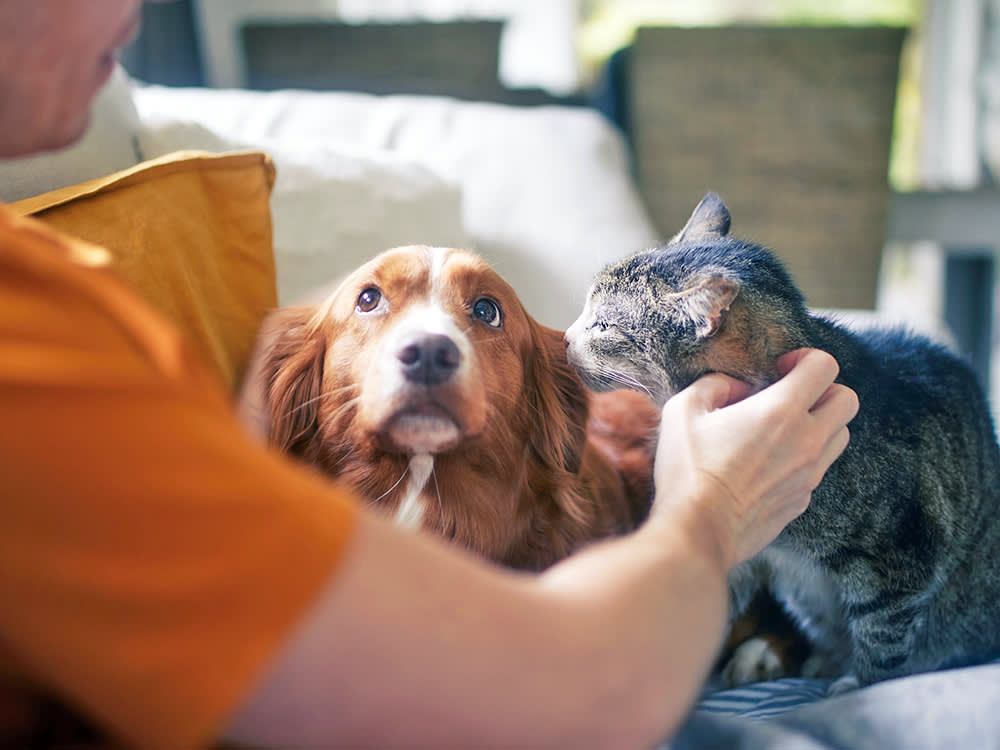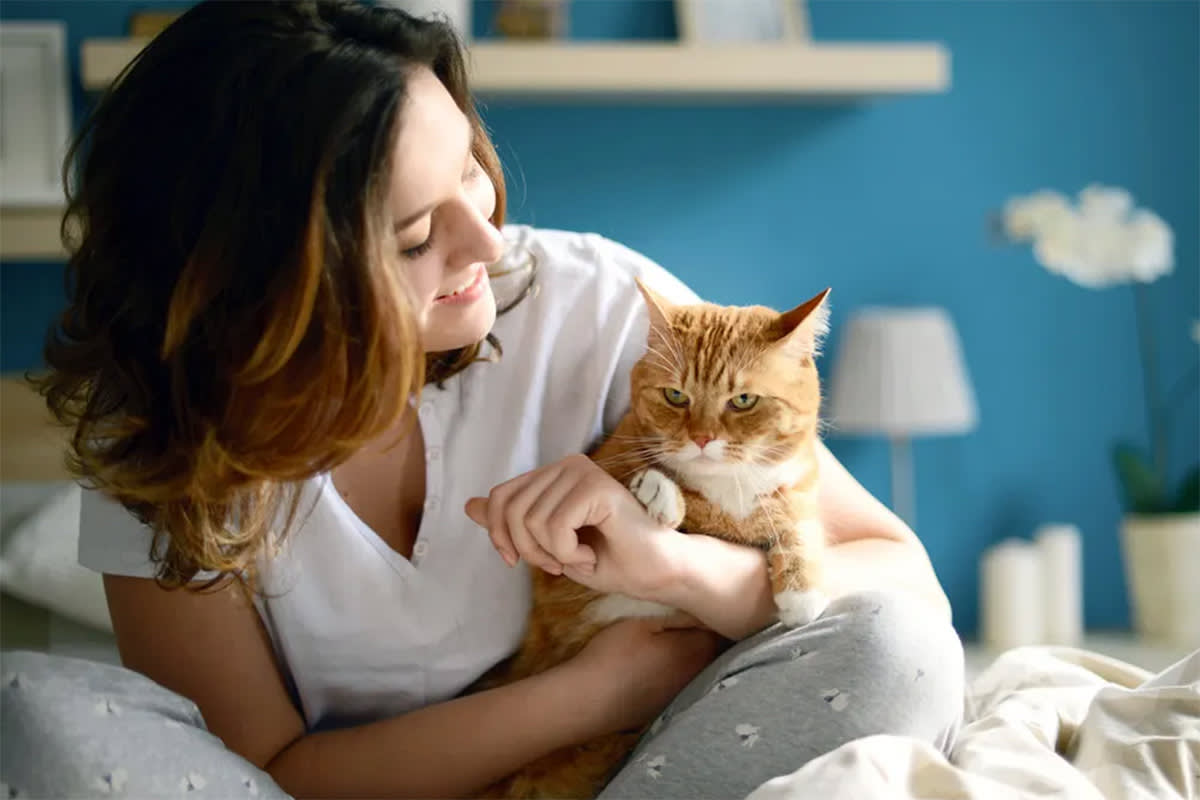Study Says Dogs Can Recognize Human’s Faces but Cats Can’t—Why?
Evolution may have something to do with it.

Share Article
As an adoring pet parent, you’ve likely spent an inordinate amount of time studying the faces of your pets, and you’d probably have no trouble picking them out of a crowd. But whether your pet would be able to do the same for you is more of a toss-up. A study showed that while dogs can almost always recognize the face of a familiar human, cats appear to have little to no human facial recognition.
Published in Journal of Vision, the 2005 studyopens in new tab selected 12 dogs and 12 cats, and assigned each of them a human handler who worked with them for two hours a day for six months. The animals spent this time learning how to use the experiment’s testing apparatus — essentially, a system where the animals were given two visual stimuli and asked to choose one.
After six months of training, each animal was given four pairs of visual stimuli:
1) the face of their handler versus an unfamiliar face

2) the face of an animal who lived with them versus an unfamiliar animal
3) a previously learned natural scene versus an unfamiliar one
4) a control pair, consisting of an unfamiliar natural scene versus another unfamiliar natural scene.
The animals then had to make a selection from each pair (and were rewarded regardless of which choice they made). Each of the four selection processes was then repeated 50 times, to accrue more data for statistical comparison.
How the results differed
In the latter three tests, the dogs and cats performed roughly the same. But in the first matchup, the dogs chose the face of their handler about 88 percent of the time, while cats chose the familiar human face only 55 percent of the time — performing at a rate barely better than random chance. Therefore, the study concludes, “dogs are able to discriminate their handler from another human based solely upon face recognition,” but cats aren’t. However, cats were equally as skilled as dogs at recognizing familiar faces from their own species, so it seems it’s just our faces that are a problem.
While the study doesn’t draw any firm conclusions about the reason for the discrepancy, animal behaviorists do have some guesses. “We know that dogs have been around humans for a lot longer than cats have,” says cat behaviorist Stephen Quandt. “Dogs developed a social need to be with us, and they're social pack animals. It was probably helpful or necessary for them to be able to distinguish one human face from another.”
Why cats are worse at facial recognition than dogs
Cats, on the other hand, were domesticated only about 10,000 years ago, and their historical relationship with humans was far less involved. “[Cats] didn’t live with social groups with us, and so there was no need on an evolutionary level to have human facial recognition, because it served no particular purpose,” Quandt says. “They didn’t inherit the genes to allow them to make that recognition.”
As cats’ relationship with humans gradually became much more interdependent and friendly, they’ve learned to make up for their lack of evolved human facial recognition and now simply rely on other cues to tell us apart. Quandt says a cat may distinguish their human parents from other people based on a combination of factors — including smell, voice, manner of movement, and general size/shape.
Rachel Gelleropens in new tab, another feline behaviorist, agrees, saying that scent is the main way cats tell humans apart. “[Cats] have a very strong sense of smell, and smell is their most important sense,” she says. “Even if [several humans] all live in the same house and share many scents, they can still discern your unique smell.”
Cats have also learned to tell human beings apart by their voices, which was actually the subject of a separate study conducted in 2013opens in new tab and was confirmed again in a study this Mayopens in new tab. “They do know our voice from other people’s voices,” Geller says. “They can remember the pitch, the intonation, the timbre, and the volume we tend to speak at … They're still pretty refined in their ability to recognize and to differentiate.”
Humans are fairly unique within the animal kingdom for relying so heavily on eyesight to navigate the world, and Geller also points out that feline eyesight is not as strong as ours. A cat’s vision is optimized for hunting, so while they have superior night vision and movement detection, they don’t see well at far-away distances and don’t see much color. “They just don’t have that natural ability to detect visual details, especially during daylight,” Geller says.
Dogs may have been domesticated as many as 40,000 years ago, and their survival and evolution as a species frequently depended on being able to figure out which humans were friendly and which were not. Over time, they developed not only the ability to tell one human face from another, but also the ability to read our facial expressions opens in new tab and interpret our emotions.
Given their comparatively brief friendship with humans, reliance on smell, and middling eyesight, cats have failed to evolve in quite the same way. But don’t worry: Even if your cat may not be able to fully appreciate your beautiful face, they’ve still got their own methods for recognizing their most trusted human companions.

Rachel Pick
Rachel Pick is a freelance writer and social media editor who has written for Vice, The Guardian, and SELF. She lives with two cats: Cricket, a genteel lady who is the picture of refinement, modesty, and good manners; and Cowboy, who is an agent of chaos, slapstick comedy, and foul odors. Her work here frequently focuses on cat companionship and cat behavior.
Related articles
You Consider Your Dog a Part of the Family—But Do They See You the Same Way?
Experts say pups definitely know who’s in their “group.”
![Man laying with his cat on his stomach outside.]()
10 Signs Your Cat Trusts You
And what you can do to strengthen your bond even more.
![Funny orange cat walking over people's legs at home.]()
7 Signs Your Cat Is an Extrovert
They’re not all moody loners.
Viral TikTok Challenge Asks: Would Your Dog Recognize You on the Street?
And got some pretty hilarious answers.
Do Cats Actually Like Being Pet?
No touch-y!
Every Dog’s Biggest Need, According to Their Breed
Because those animal instincts run deep.







